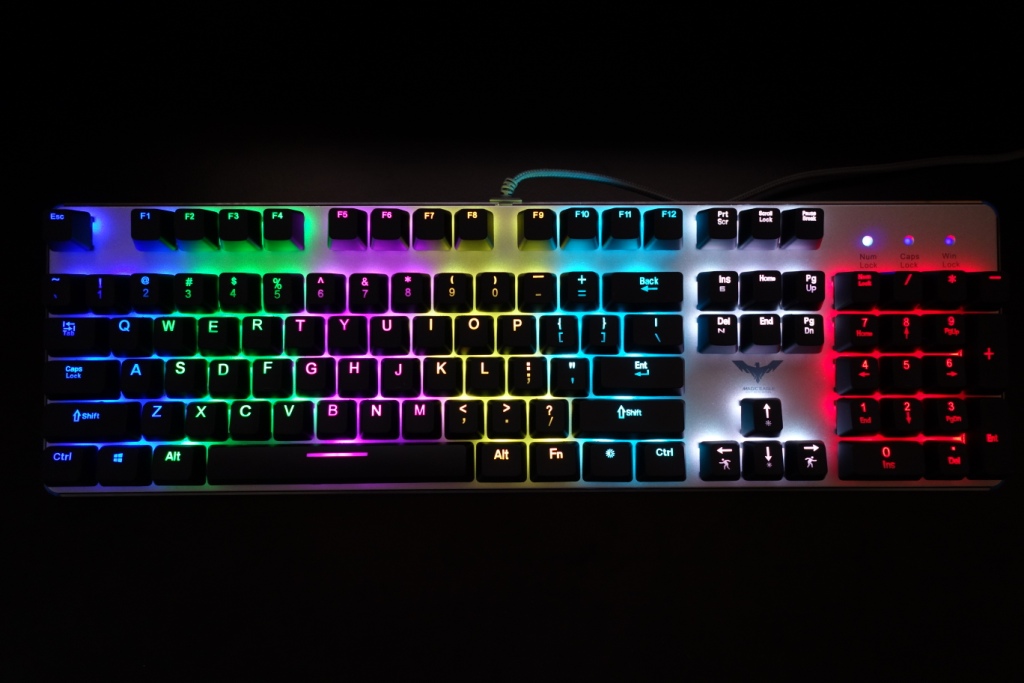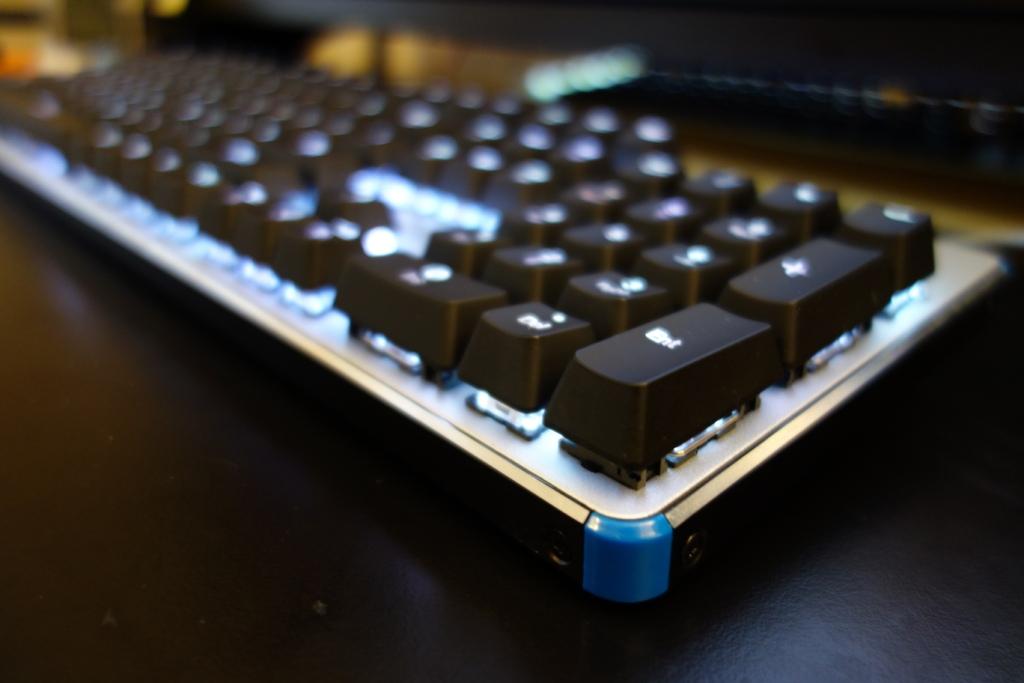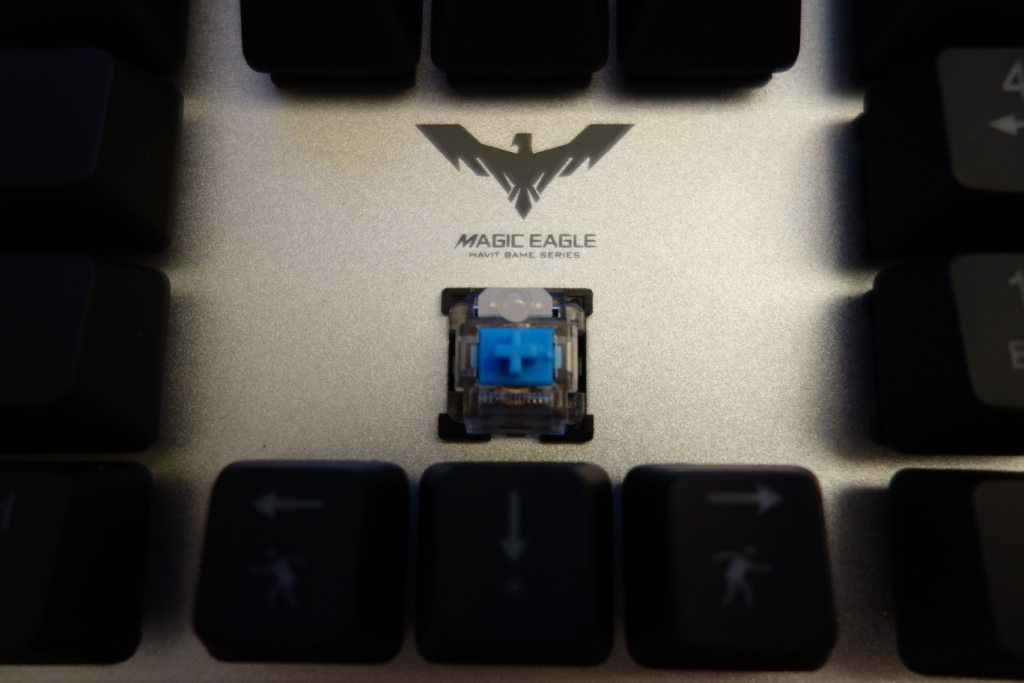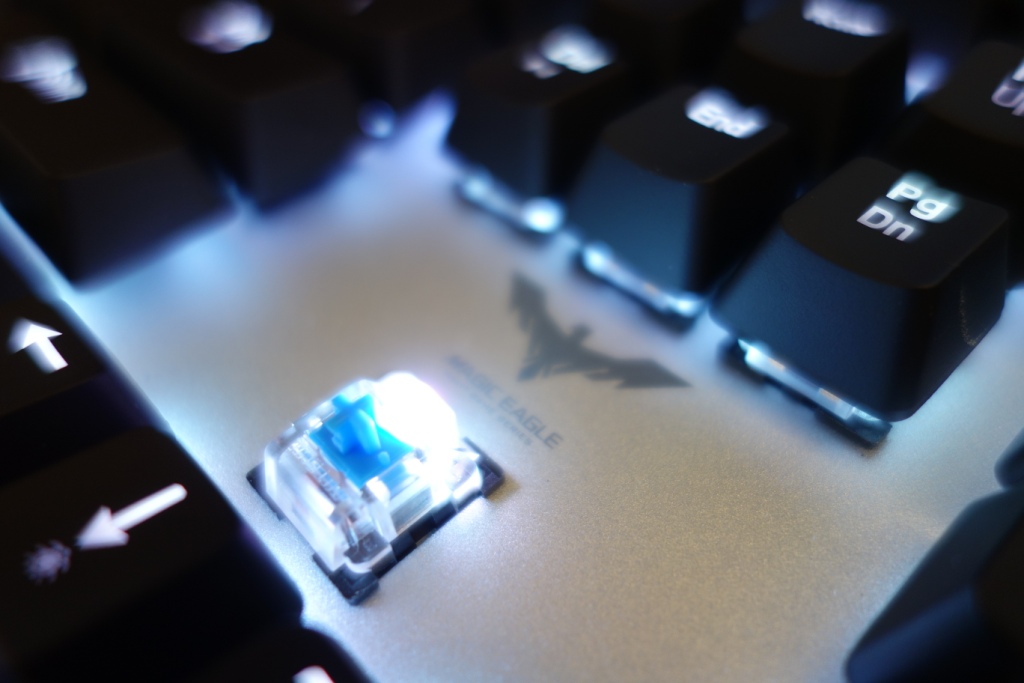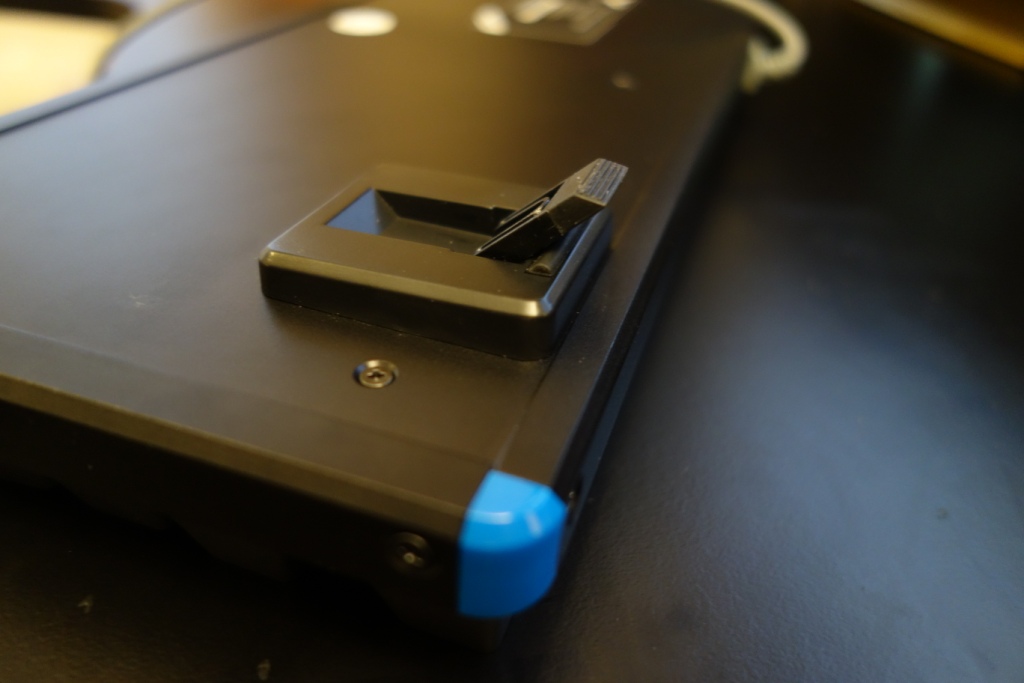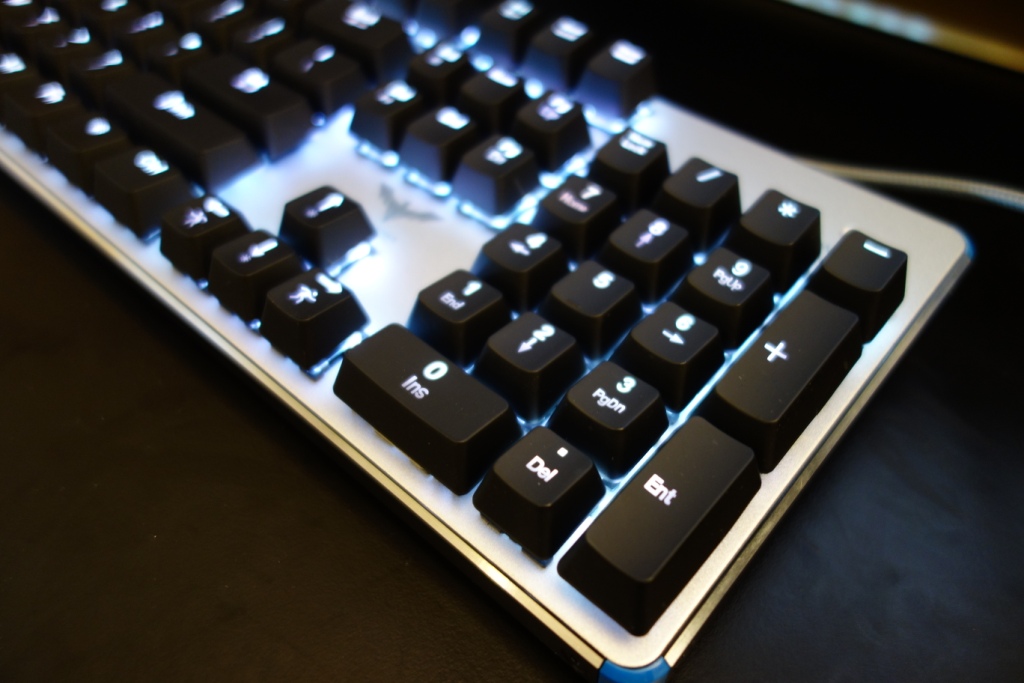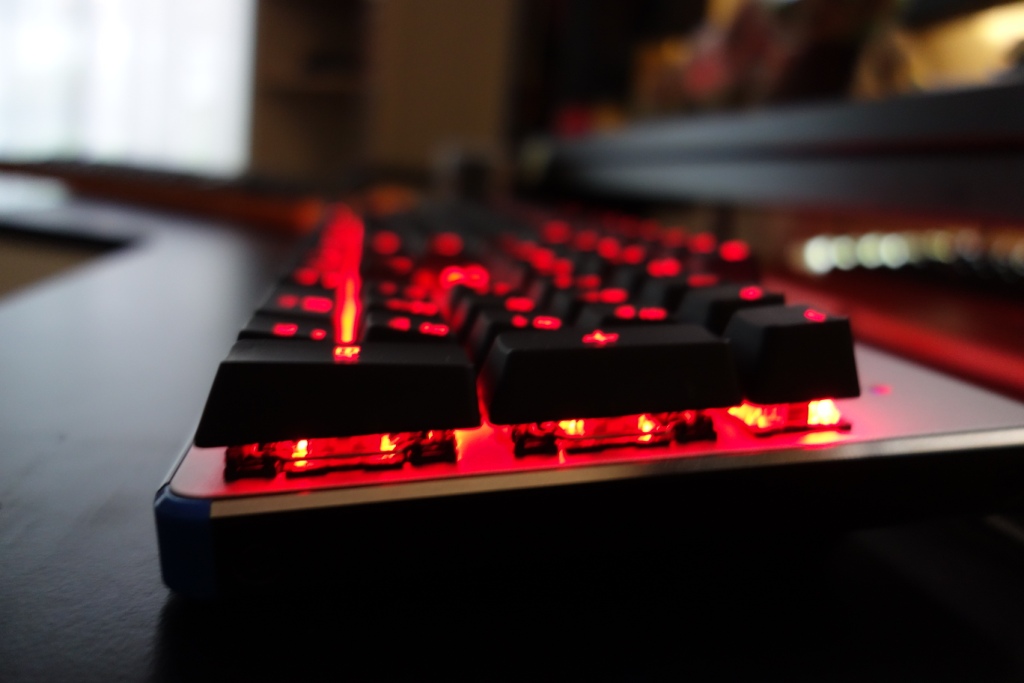Pros: Design and build quality, RGB colours, clicky-sound is satisfying (subjective), price
Cons: No wrist rest, not a well known Chinese switch manufacturer, no additional accessories, RGB colour is per section and not individual, heavy switch to type on (subjective), little bit of key cap flex, available in US layout only
Build Quality & Accessories: 8.5/10
Design & Look: 9/10
Value: 8/10
Performance: 8/10
My final Rating: 8.5/10
Review Date: October 2015
Review Price: £70 (can be found in the US for cheaper at $90)
First of all I would like to thank Gary from HAVIT for sending me the keyboard for review.
After having previously reviewed various mechanical keyboards that had various different mechanical switches on them, I was intrigued to see what HAVIT had in store. I’ve previously been really impressed with the price to performance ratio from HAVIT products – where they’ve been able to produce good quality products at an affordable price.
The HAVIT HV-KB366L can be found for around £70 on AmazonUK and around $90 on AmazonUSA. As you’ll be able to see from the conversion rate, the price in the US is much more favourable, however as I am based in the UK, I will be reviewing it at the UK pricing and availability.
On another note, this keyboard can unfortunately only be bought in a US layout. At the time of writing there’s currently no UK layout available, which can be a deal breaker for some.
Before getting into my written review, here’s my video review of the HAVIT HV-KB366L:
Now let’s get into this written review!
Build quality
Jumping straight into the written review, I would first like to talk about its build quality, which to me is astonishingly good, especially considering its price tag of £70. I should note that the keyboard only came with a manual and nothing else – I would have liked to see see a key-puller included too.
The keyboard is terminated by a single gold-plated USB, which is used to power and connect the keyboard. The cable used is also braided and is finished with a grey design.
Underneath the keyboard, there’s rubber bits that prevent the keyboard from slipping and two keyboard risers. I found the keyboard risers to be quite thin and small, which would have been better served if they were slightly thicker and wider – this is for the prolonged use of the keyboard, especially considering the whole body of the keyboard is made out of solid metal.
This leads me to my main point of its construction. The build quality of this keyboard is phenomenal as it’s built entirely of a metal construction, which is impressive to see, especially considering its price. I’ve rarely seen keyboards made out of solid metal and it was a surprising change to receiving plastic-made keyboards that I’ve become accustom to. This does mean the keyboard is heavy to carry around, and I know a few people take their keyboards to LAN parties and/or backwards and forwards from work – so if you’re looking for a portable, lightweight keyboard, I would look elsewhere as it’s heavy.
Moving on from the shell of the keyboard, to the mechanical switch that the HAVIT HV-KB366L has, the Gaote/Outemu “blue” switch. More information (only found in Chinese) can be found on Gaote’s website, however with the use of Google translate and with the help of Gary from HAVIT, the most important information you’ll need and want to know is that it has an actuation force of 80 cN (grams). With its clicky nature, the switch is extremely similar to Cherry MX Greens, which have an actuation force of 80-90 cN. The Cherry MX Greens are known to be quite rare to find, simply as they’re entirely made for heavy typers, which are less common to come across. This comes from the Cherry MX Blues having an actuation force of 45 cN, providing the user a easy click without using too much force. As this is all subjective it will depend on you, however I personally found the Cherry MX Greens and the Outemu switch to be harder to type on. In terms of a comparison I found the Outemu “blue” switch to be a little more accurate to press in comparison to the MX Greens, which when compared made the MX Greens feel mushy. I found that quite intriguing myself as they also produced a sharper sound when being pressed.
Now in terms of the switch itself, it has the same Cherry MX stem, which is great if you have custom keycaps, as you’ll be able to use them on your HAVIT keyboard. When looking closely at the switch, you’ll be able to see it’s clear and that it has a LED located at the top of the switch, very much like the older illuminated Cherry MX switches. I did find the keys to be well illuminated and due to the switch being see-through provided a nice hue throughout the bottom of the key cap. I did however feel the LEDs were slightly shaded rather than having a clear coating. In other words, like buying a light bulb which is pearl coated, rather than clear.
I should also mention the key caps themselves. I felt the key caps were reasonably made, almost like a hybrid of a Logitech G710+ and a CM XT – which means it’s not fantastic, but relatively good. On a separate note, something I did notice, which to me was a little odd, was that the key caps would have a little bit of wiggle room whilst being on the switches’ stem. This means sometimes a letter might not look completely straight, but at a slight angle – it’s not something that’s massive to me, as it’s hard to notice, but it’s something I did find when typing hard and fast on the keyboard.
Overall, I was really impressed with the build quality from top to bottom. In a more subjective comment, I feel the switches weren’t really well placed for their market audience. Often people who buy Cherry MX Blues are those that want that audible clicking sound, and therefore use to to touch type. Having a 80 cN actuation force means you’ll need to be someone that is a heavy typer. I’m not saying there’s not many of them around, but if you’re jumping ship from membrane rubber dome keyboards to a mechanical one, I think you’ll find it a major difference in typing.
On a separate note, there’s no need of any software to run this keyboard, as all the controls (which I’ll get to in the design section below) can be controlled via the keyboard. This is great as there’s no need to faff around trying to install drivers or software to make the keyboard run.
Design
Moving on to its design, I found the keyboard to have a great overall design, from its solid metal construction to its RGB lit keys. One thing to note about its design is that the keyboard has a subtle little blue colour to it, with the edges being finished with a blue paint indicating it’s a “blue” switch keyboard.
The RGB keys work as you would intend, however aren’t as “independent” as other switches I’ve tested. By that I mean I felt that the keys were lit by section, rather than individually lit – it’s hard to explain, but if you compare this keyboard (by watching my video reviews) with the SteelSeries Apex M800 for example, you’ll notice what I mean. This to me was a little disappointing, but somewhat expected from a keyboard at its price range.
Other than that, the keyboard does great with its functionalities, via the Fn key which is used to control various aspects of the keyboard. Be it from the colours of the LEDs, to the pattern they display, to the overall brightness. A small note on the brightness, when putting it to max, then re-cycling through your colours, you’ll find the brightness reverts back to it’s default value and not the intended max that you set it at. I’m not sure why, but this is something to note if you like changing colours a lot. Using the same Fn key, you can also perform a Win-Lock, which means there’s no accidental press of the windows key that can occur as you’re gaming. A small nifty little feature.
One thing that did disappoint me with the Fn key is that there were no dedicated media keys. Often you see the Fn key used in parallel with the F5 to F12 keys, in order to play/pause etc music. I would like to see it implemented here and I’m sure it would haven’t been hard to include, as I’ve seen it on other keyboards that also don’t require any software.
Finally, as said before, this is a US layout keyboard and it’s a shame as in terms of design I really like having a big enter key and the right keycaps in the right positions.
Overall the design is very good, although not flawless. Considering it’s price I think I’m being a little harsh on it, but I feel there are worthy points to draw out here that might make you aware of the purchase before actually making it.
Conclusion
In conclusion, this keyboard provides one of the best built keyboards I’ve ever comes across – and that’s coming from someone who type on a custom painted Lamborghini G710+ and CM XT. The build quality is really one of the stand out features for me. It’s weakness I feel is it’s switches. As they’re relatively unknown and not really that throughout tested it’s hard to say if they will last as long as a Cherry MX switch would, either way that’s just an observation rather than a fact.
When considering its price of £70, and even more so its price of $90, which works out even cheaper, it’s really easy to recommend this keyboard. I don’t think you’ll be able to easily find a full-metal mechanical keyboard, that’s also RGB lit for that price. If anything it’s triple if not more to buy something like that!
Hope you enjoyed my review!
–TotallydubbedHD

